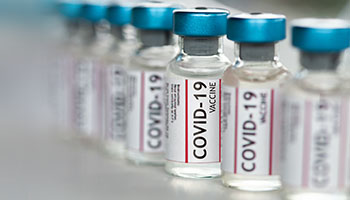HOW CAN WE HELP YOU? Call 1-800-TRY-CHOP
In This Section
Looking Ahead to a Vaccine for the Coronavirus: Q&A With Paul Offit, MD

Paul Offit, MD, director of vaccine education at CHOP and an internationally recognized expert in the fields of virology and immunology.
As news of possible pandemic relief spreads globally, we’re proud to say we have one of the world’s leading authorities on vaccines working among us. Paul Offit, MD, director of the Vaccine Education Center at Children’s Hospital of Philadelphia, has been busy making the media rounds, as he shares his knowledge and insight on the pending vaccines that will protect us against the coronavirus. He’s no stranger to the rigorous research and testing of new vaccines, as he is co-inventor of a landmark vaccine achievement for the prevention of rotavirus gastroenteritis. He sits on the U.S. Food and Drug Administration’s Vaccines and Related Biological Products Advisory Committee (VRBPAC), which provides independent advice to the FDA, and has just this month, recommended emergency use authorization for two COVID-19 vaccines — meaning the first group of American arms are being inoculated before the end of the year.
We caught up with Dr. Offit to get his input on this COVID-19 vaccine advancement and to share his expert knowledge.
Based on your perspective as a co-inventor of a vaccine and a professor of vaccinology, how do you describe the immense accelerated effort with so many ideas and strategies underway to make a COVID-19 vaccine?
I think we will look back at this year as a technological marvel. We had this virus, SARS-CoV-2, in hand and could sequence its genome in January of 2020. Now, roughly 11 months later, we’ve performed two large clinical trials of a novel vaccine strategy, mRNA, which appears to have remarkable safety and efficacy profiles. So I think it’s been amazing, actually.
As of now, eight companies are in the midst of phase 3 trials — large prospective placebo controlled trials — to prove safety and efficacy for the vaccine’s approach. Can you briefly set the stage for us and explain the characteristics of the different vaccine strategies such as the mRNA vaccines and the replication-defective viruses?

Pending vaccines that will protect against the coronavirus.
These are genetic vaccines, which means that we aren’t inoculating people with the actual virus, and we aren’t inoculating people with any of the viral proteins. We’re not taking a virus and inactivating it, as we do with the inactivated polio vaccine. We’re not taking a virus and weakening it, which is what we do with a measles vaccine. And we aren’t taking just a protein of the virus, which we do with the hepatitis B vaccine.
What’s being done with these vaccines is that we are inoculating people with the gene that in this case codes for the SARS-CoV-2 spike protein. The vaccines can deliver the gene as mRNA or DNA. Or they can deliver the gene as either replication-defective or replication-competent viral vectors. That’s the difference between all these strategies, but they’re all essentially genetic vaccines.
You’re part of the FDA’s vaccine advisory committee, which consists of academicians, independent of the government and the companies, who discuss and debate these vaccines and make recommendations to the FDA. When you’re participating in these virtual meetings, most recently Dec. 17, what are the most pressing questions that you want answered?
We’ve all seen the press releases from these drug companies, which gives us the top line data — the tip of iceberg. What we want to do is examine the base of the iceberg to make sure that there’s no cracks, to make sure we can look much more closely at these data to see whether there are any possible problems. So, for example, the vaccines appear to be highly effective, about 90 percent, 95 percent effective. But there were people who got the vaccine who still got sick. Why did this happen? Was there any unique characteristics about these 11 people in one trial who got the vaccine but still got disease? Did they not develop a good immune response? If not, why not? Were they older? Did they have any medical comorbidities? That’s that sort of stuff you don’t see in the press releases.
What kind of data is the committee looking for to comfortably recommend a vaccine to be given to the American public, especially since these are novel vaccines that are coming from bench to bedside?
Well, you want to make sure that these vaccines will be handled like any vaccine. There will be safety profiles for two months after the last dose on tens of thousands of people, which is pretty much true for all vaccines. And when there’s a problem, meaning a serious safety problem, usually it comes up within six weeks of a dose, so that’s enough time to see whether or not you can say that there is not a “relatively uncommon, serious side effect.”
The big difference between these vaccines and a typically licensed vaccine is the length of study time — and not so much for the safety issues, but more for the efficacy issues. We’re looking at effectiveness of these vaccines a week or two weeks after the last dose. That’s peak immunization time. So what can be said is that these vaccines are 90 or 95 percent effective within a couple of months of giving them. So then the question becomes, is it also effective for six months? One year later? Two years later? That’s the kind of data we have for other vaccines. For instance, the human papillomavirus vaccine was a seven-year study. Our rotavirus vaccine was a four-year study. Those are more typical.
On the other hand, they’re not going to do a two- or three-year study of this vaccine to see how long it’s effective, when 315,000 plus people are dying in the U.S. this year of the coronavirus. We have to take a leap, to some extent. But if a vaccine is highly effective after a couple of months, it’s likely to be effective for six months. So I don’t think that’s a very big leap.
Two major pharmaceutical companies announced in November their mRNA-based vaccine candidates against SARS-CoV-2 achieved success — over 90 percent efficacy — in the first interim analysis from their Phase 3 study. What exactly does 90 percent efficacy mean, and for perspective, how does it relate to the seasonal flu vaccine efficacy?
It means that nine out of every 10 people who get the vaccine — if exposed to the virus — will be protected against disease caused by the virus. So if you compare that to the flu vaccine, that’s much better. The flu vaccine is closer to 50 percent efficacy.
Why is it important to make the distinction that these novel vaccines are not licensed products, but essentially would be permitted under emergency use authorization?
I wish we had a better phrase. When people hear emergency use authorization, at least what I think of, is hydroxychloroquine and convalescent plasma, which the FDA permitted for use, even though neither product had been shown to work. That’s not this. These vaccines are tested pretty much to the level of any vaccine, with the exception, obviously, of length of study for the efficacy. So I wish we had a different category. I wish we could call it a licensed product / pandemic version. That would, I think, scare people a little less. The real difference is how we went about efficacy. That’s the biggest difference between this and a typical vaccine — the length of time that you’re following-up for efficacy.
So far, has any of the initial efficacy and safety testing of the COVID vaccines involved children? And if not, what are the next steps for getting adequate data to provide a vaccine for our pediatric and adolescent population?
Both pharmaceutical companies whose vaccine studies we reviewed are looking at children down to age 12. Those data will be available soon. That’s probably the way this will play out — you’ll see children tested at progressively lower ages over time.
After a vaccine is distributed broadly, we won’t immediately know how long protection is going to last or if it will cause a rare side effect. How are vaccines monitored during this learning curve right now?
Pre-approval, we can say that the vaccine doesn’t have a “relatively uncommon, serious side effect.” But 20,000 people, isn’t 20 million people. So we can’t say that it doesn’t have a very rare serious side effect. The only way we’ll know that is after the vaccine is approved — which is true for any medical product. No medical product is tested on 20 million people before it’s put out in the population. There’s a system called the Vaccine Safety Datalink, which is a linked computerized medical records system of a variety of large health maintenance organizations in the country. One can see very quickly who has received vaccine and who hasn’t. And if there’s a problem that comes up, researchers will be able to see that it’s occurring in the vaccinated but not unvaccinated group. That’s probably the best system that’s out there.
What does the vaccine mean for social distancing and mask wearing? Will we be attending large weddings and graduations, sans masks any time soon? Or will we need both hygienic measures and vaccines to stop the spread of COVID-19?
We will need both. First of all, even if the vaccine is 90 percent effective, that still means one out of every 10 people can still get sick with a virus that can kill you. Secondly, and more importantly, we don’t know yet, but probably will know in about six months or so, whether or not this vaccine protects against asymptomatic infection — where you could still shed virus, still be contagious, even though you’re not sick. We know that this virus itself can cause asymptomatic infection, which are contagious. We don’t know whether the vaccine can protect against that — yet.
With vaccines in general, the goal is to protect against disease — ultimately to keep people out of the hospital and out of the morgue. And if they asymptomatically shed, you’re thinking, “That’s OK.” But then again, this is a different virus. This is a pandemic virus that has brought us to our knees. And until we get on top of it, we’re going to need to still wear masks and social distance.
Taking into consideration the vaccine skepticism that’s been circulating, what would you tell people about how to decide to get the coronavirus vaccine?
I think it’s reasonable to be skeptical — you should be skeptical of anything you put into your body, including vaccines. I think everybody that sits around the table at that FDA vaccine advisory committee is a skeptic. So my advice is, look at the data. Can you reasonably say that this vaccine has been sufficiently tested in enough people to feel comfortable that it’s safe and effective? If you’re over 65, do you feel it’s been reasonably tested in your age group? Or if you have a certain medical comorbidity, are you represented in these trials? If you’re of a certain racial or ethnic background, are you represented in these trials? That’s perfectly fair.
There’s a difference between being a skeptic and being a cynic. I think a cynic says, “I don’t care what the data says. I know that the pharmaceutical companies control the world, the governments, and the medical establishment. So I don’t believe anything I hear.” That’s not to anyone’s benefit.


